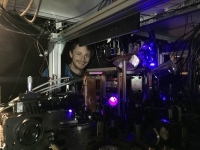Norcia
Matt joined the lab as a National Research Council (NRC) Postdoctoral Fellow after completing a PhD in James Thompson’s lab at JILA. Matt’s thesis, titled “New tools for precision measurement and quantum science with narrow linewidth optical transitions” focused on coupling a large ensemble of strontium atoms to an optical cavity via narrow and ultra-narrow linewidth optical transitions. A key outcome of this work was the first demonstration and characterization of superradiance from the 1 mHz linewidth strontium clock transition, which holds promise as a future high-precision optical frequency reference. In his role as a postdoc in the Kaufman lab, Matt explores how the combination of strontium atoms, tweezers, and microscopy can be used to create new tools for quantum simulation and information processing.
He is now a post-doctoral fellow in Innsbruck, in the Ferlaino group.

Atom Computing


 The Physics Frontiers Centers (PFC) program supports university-based centers and institutes where the collective efforts of a larger group of individuals can enable transformational advances in the most promising research areas. The program is designed to foster major breakthroughs at the intellectual frontiers of physics by providing needed resources such as combinations of talents, skills, disciplines, and/or specialized infrastructure, not usually available to individual investigators or small groups, in an environment in which the collective efforts of the larger group can be shown to be seminal to promoting significant progress in the science and the education of students. PFCs also include creative, substantive activities aimed at enhancing education, broadening participation of traditionally underrepresented groups, and outreach to the scientific community and general public.
The Physics Frontiers Centers (PFC) program supports university-based centers and institutes where the collective efforts of a larger group of individuals can enable transformational advances in the most promising research areas. The program is designed to foster major breakthroughs at the intellectual frontiers of physics by providing needed resources such as combinations of talents, skills, disciplines, and/or specialized infrastructure, not usually available to individual investigators or small groups, in an environment in which the collective efforts of the larger group can be shown to be seminal to promoting significant progress in the science and the education of students. PFCs also include creative, substantive activities aimed at enhancing education, broadening participation of traditionally underrepresented groups, and outreach to the scientific community and general public.